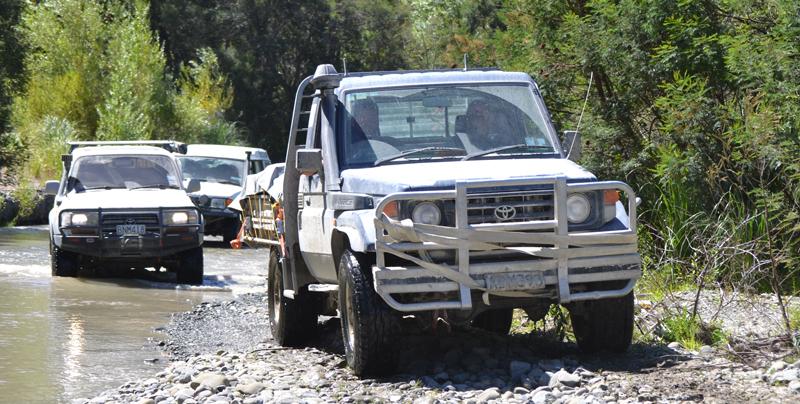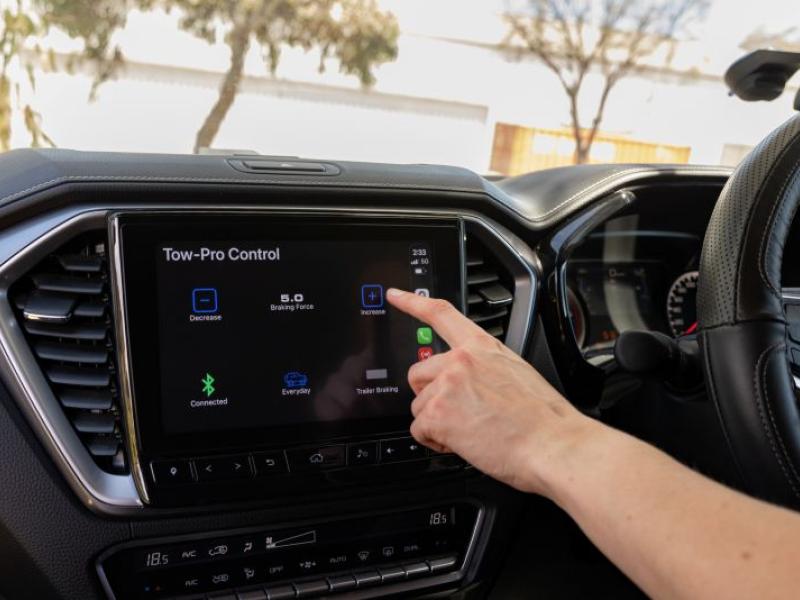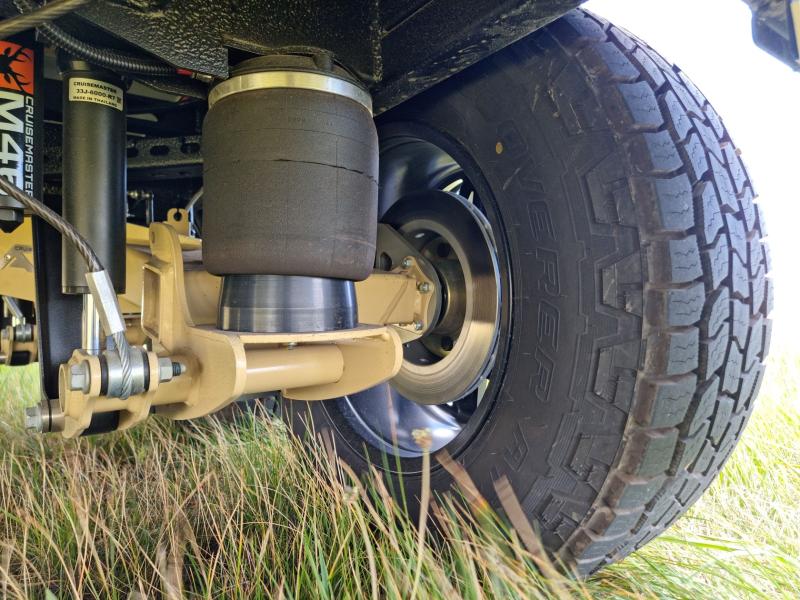Story and photo by Murray Taylor
Yes we all carry it, but the real questions about recovery gear should be, do we know how to use it (safely), and what will it actually do, when required?
The list’s actually as long as one likes to make it regarding gear, but in the end it comes down to what you personally consider worth carrying for the actual trip you’re doing. Also whether you may be a trip leader or just a trip member.
Myself, as both member and a trip leader, carry what I feel is appropriate for the trip I am about to do. The standard list of gear on board “The Whale” at any one time would be;
- two strops(snatch straps) plus a short extension
- two winch extensions (one being Dyneema rope, for through a block or as replacement for the actual winch rope)
- a joining stick
- tree truck protector
- a lightweight bridle (five-tonne tow strap)
- a range of shackles from 1.5 tonne to 4.74 tonne in most cases two of each
- a winch blanket
- a high-lift jack, and winch chain set up for the jack, plus jack block and winch block
- a spade and a hand saw.
Why I hear many of you ask?
Getting stroppy
Let’s start with the strop. A strop would have to be the most used item in any 4WDer's gear kit. As such it is also the most abused and mistreated item we carry.
The key reason a strop is both the most used (and abused) item on the list is that in most cases it only takes a small tug to recover a vehicle if all that’s lost is momentum.
If its stuck fast and you need lots of effort, then it’s time to take another look at the recovery. (see pics showing what happens when a strop breaks).
The pics are from a video at 30fps so the three pics is 1/10 of a second and it looked like the strop had just hit the tyre. But no, it had gone all the way inside and hit the safety frame behind the passenger’s head.
Care instructions
So a strop needs looking after. It should be laid out flat with no twists along its length before connecting to recovery points, (twisting can cause breakage). And at the end of a trip if it’s been used and is muddy etc, it will need a good thorough wash and dry (not in the sunlight, either).
It also pays to check it for nicks and fraying along its length, around the stitching and especial around the eye. If you find any (nicks or fraying) present cut it in half and replace it. Because if you don’t, trust me, it will break under load.
While we are on the subject of looking after a strop, they should not be left out in the sun (i.e. on the front of a truck) all their life. Also remember if it’s been used real hard a strop will lose some of its effectiveness… the reason to always carry two, as one can be damaged so easily.
Extension course
Next in line is the short extension and joiner which are used if the nine metre strop is not long enough. Never join strops (a recipe for a problem), and always use a joiner, (never a shackle) unless you would like to throw two items of gear away.
Apart from the shackles most of the other gear is involved with winching exercises - great things to have in your gear kit, or door pocket, but not the greatest item/s to have hanging off either the back or front of your truck unless holding a winch hook.
Shackle do’s and don’ts
As one does not use a shackle on a shackle (unless you are working from small to large) in almost all cases to use a shackle on a vehicle if needed (i.e. no hooks fitted) one has to remove it first.
Now if it’s tight and needs tools, well it’s not me who will be looking for it in a few feet of mud! In most cases if shackles etc are in use so are the following items; winch block, tree truck protector, winch and winch blanket etc.
At this stage it’s a good idea to have a cup of tea, (in other words sit and think about what one is about to do. Rushing in, in most cases, will not help. Often, in fact, it only make things worse, and one chief in control is what’s required) then the recovery can take place.
I will admit that most of the gear I have assembled and carry (apart from the strop) will sit around for extended periods of time. That said, it has been called upon over the years, one just never knows when. For instance
High Lift jack and chain
The high-lift jack and chain for winching has been out of the truck a few times over the years. This has normally been for maintenance of a vehicle while on a long trip. But what about the chain for winching I hear you ask?
Well, like all things in life truck winches do fail when least expected so it’s a backup for that winch. Why in the truck? For a start it’s made of steel and if it was outside it would get wet, rusty, covered in dust etc, all things which will not help it work when you really need it. Unless, of course, you carry CRC, grease or even a repair kit, or it’s in a boot on the outside….
Spade
I always carry a spade with me as there’s always a possible need to dig a wheel track across a slip or remove an obstacle along the way.
The same with the saw, which is there to cut that offending branch, which could add to the pin striping down the sides. You never know when it will come in handy. The gear’s there if and when required, and for some of the longer trips down south etc.
Other options (depending on the country) include a chain saw, and all that goes with it, a ground anchor (not the competition-style anchor) and sand tracks (which come in all different colours and styles these days).
The latter are effective but speaking strictly personally here I see no need for them as I am not doing the miles of sand travel that Australia and a few other countries have. That said they are also great if you are travelling by yourself, and can even work in mud if you do not have a winch.
Despite being a lot smaller my other 4WD, “Little Whale” (a Suzuki SJ413. Ed) has almost the same gear inside, but not the double up like “Big Whale” has i.e. no second strop, or extension and no high lift jack or chains, and again I add gear for the country I am about to travel in.
The bottom line
The bottom line is that what you carry and use is your choice, or a factor of payload/space depending on your truck.
In almost all cases however (and here we are talking club trips and Safaris), the minimum recovery gear is a shackle( 4.75t) if no hooks fitted, a rated snatch strap, six or nine metres in length and a shovel or spade.
That’s the recovery gear only and like all recovery gear it should be in good condition and you should know how to use every piece (of recovery gear) if and when required.
When he asked me to write this the Ed asked me for a real world (which I have covered so far) and an ‘ideal world’ list of recovery gear I would like to carry with me.
Safety first
Funnily enough, the answer to the second question is…’ideally nothing more than what I have at the moment. But that is because the ideal trip is the one where you have all the gear but never use it because it’s a 4WD you are driving and it is your own skill in driving it that’s gets you to the end.
That said, once you get beyond a typical Shiny 4x4 trip category, you will almost always need and use the extra recovery gear that’s in the truck because that’s the joy of the trip, getting through the obstacles!
To be safe is the ideal and that in most cases means think about what you are about to do in regard to using recovery equipment before you do use it….. ( the tow ball in the tail gate’s been around for years yet you still see it happening today).
If in doubt ask, but always enjoy the trip you are on.
To read every story in the May 2017 issue of NZ4WD go to Zinio.com (April 21) or purchase your own hard copy at the Adrenalin store.






